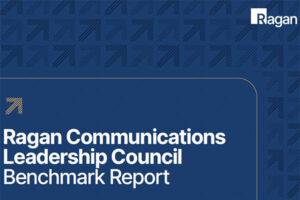Designing an integrated planning process to embed comms across your organization
How Thrivent CCO Greg McCullough led a modernization of the comms function that positioned the team as a catalyst for enterprise business transformation and growth.

When Greg McCullough was named Thrivent’s first-ever CCO in 2022 to lead a transformation and modernization of the comms function, he knew that upskilling the team would be a fundamental first step along the road.
Working directly with Thrivent CEO Terry Rasmussen to understand the needs of the business, McCullough recognized that adding new capabilities through modernization was a priority. Several focus areas were important for successful modernization:
- Foundational education on various communications disciplines. Starting with a baseline understanding of roles, how those roles met business needs, and how those roles could work together in an integrated way to produce greater impact was essential as McCullough worked to unite previously siloed comms teams and functions. “Each of our teams – including PR, internal communications, executive communications and more – spent time together in immersive workshops to explain their work to colleagues and examine how to work together effectively as a team,” he said.
- Understanding org-wide strategy and objectives. Understanding these things allowed the comms team to begin developing goals, strategies and metrics that connected back to larger business priorities. “The focus on strategic planning required us to learn how objectives, goals, strategies, and plans are created, and why they are important and why they need to connect – from the individual communications role up to the C-Suite,” explained McCullough.
- Upskilling around audience segmentation, listening and strategic planning. “We dug into data on our audiences to understand who they are, how they work, what they need and how we can most effectively communicate with them. This audience-based approach required us to think differently and work with our cross-divisional partners and executive leaders differently. We had to become consultants – not only recommending the best communications strategies and tactics, but pushing our internal leaders and teams to think through outcomes of communications and develop a 360-degree stakeholder approach.”
- Tapping tech platforms. Upskilling was accelerated by using new technology platforms to train the team, and investing in new talent to ensure the team was set up for success. “We hired a senior product owner, for example, to help us use technology to better reach and engage our employees – and implement new technology solutions with our audiences in mind.”
Rising to the charge of consolidating siloed comms teams into a cohesive, strategic unit, McCullough now frames communications as a team sport “where we work and accomplish more together and focus with intensity on integrated planning as the superpower that we can bring to the broader organization.”
Understanding that this integrated planning process was new to everyone on the team, McCullough saw an opportunity for everyone on the team to learn together. Putting together a process map with everyone’s specific roles and responsibilities, then training the team on how it informed the integrated planning process, provided a tangible blueprint for how to work together.
“Once we defined the roles and processes, we asked for volunteers and picked six important projects to pilot the new integrated planning process – training the leaders of the six projects on the process and supporting as the work shifted from strategy to execution in the integrated teams,” McCullough explained.
The pilot produced enough compelling insights and measurable improvement in results to share with the wider comms team and get colleagues on board with working that way in the future. Leadership was pleased to see that the results of these project pilots—which included everything from readership and audience engagement to partner feedback—were overwhelmingly positive. Moreover, the results showed the value of the integrated planning process.
“It was encouraging to see that the results of the pilots – from the readership and audience engagement to the partner feedback – was overwhelmingly positive and it helped show the value of working together in a new way.”
Driving collaborative behaviors
By thinking about promoting cross-organizational collaboration as a behavioral change, McCullough and his team were able to focus on actions like the sharing of knowledge, resources and insights that ultimately promoted a holistic communications approach.
“We had to encourage open, ongoing dialogues about projects, goals, and strategies, and be willing to provide and receive feedback from colleagues across different departments,” McCullough explained. “Working in an integrated manner requires transparency in actions, decisions, and outcomes. It involves openly sharing successes and failures, learning from both, and holding one another accountable for the results of the integrated communications efforts.”
Setting a precedent with new hires
Setting these expectations when hiring and onboarding talent was crucial. Ten new employees have joined the Thrivent comms team since the rollout of this integrated planning process, and McCullough has set an expectation that they are expected to develop strategic comms capabilities while maintaining a client focus.
The team has embraced the effort to raise expectations in its talent management strategy:
- Defining clear expectations of each role. “We start by clearly defining roles, including both the technical capabilities required and the service-oriented competencies expected,” McCullough said. “We highlight the importance of a service mindset, personal ownership and accountability for results, and integrated planning in the job description and how it intertwines with communications responsibilities.”
- A structured interview process. “We built an interview process that evaluates both technical skills and soft skills, using behavioral interview questions to assess how candidates handled scenarios in the past.”
- Incorporating practical assessments. Including practical assessments during the interview process that simulate real-world communications challenges and client interactions has also proven successful. Thrivent asks all candidates to share past examples and requires a writing component, too.
- Involving multiple perspectives. “We include team members from various roles in the interview process, selecting employees who will work closely with the new hire so they play a role in selecting new talent,” said McCullough.
Integrated planning in execution
The integrated planning process has proven successful for a number of projects, including the creation of Thrivent’s signature “Live Generously” t-shirt, which clients and friends can earn by participating in volunteer projects. “Each year, we ask our members to vote on the new t-shirt design,” McCullough explained. “It’s a fun engagement moment for our team and clients.”
Building an integrated plan for the t-shirt campaign with communications and marketing last year included a feature story on Thrivent’s intranet that highlighted the history of the shirts and shared new design options for the year. A client-facing version of the story spoke to the impact that the t-shirts have made on the community over the years. An earned media push even brought wider coverage of the t-shirt voting campaign to wider audiences and included a feature on CBS News:
“The results were strong. Our integrated planning, our willingness to ask ‘what if’ and try creative new ways to tell the story of a fun annual tradition at Thrivent paid off. We got results that we hadn’t achieved before,” McCullough said. “We drove strong engagement with more than 25,000 votes for the new shirts, and drove 1,000 new visitors to Thrivent.com, and instilled pride within our workforce.”
Other metrics prove this integrated communications model, which has been applied to allf strategic initiatives at Thrivent, is working. The team implemented an important new tool to measure the clarity and impact of its comms internally, and found that results were at or above the industry benchmark on all measures.
“Rather than just measuring clicks, opens and likes on information about company strategy, we’re asking our colleagues if they understand the strategy and can link their work to it. It’s a higher standard of accountability and it gives us a baseline to measure our improvement in future years,” McCullough said.
Additionally, Thrivent found:
- 98% of enterprise leaders said that they understand how their work supports Thrivent’s strategy.
- The corporate intranet, a key comms platform, saw a 226% readership increase in 2023.
- Partner feedback has been overwhelmingly positive. “We can show executives and partners one integrated communications plan instead of separate tactics, and they better understand and appreciate the cohesive communications strategy,” McCullough said.
Bringing clarity to the org chart
Thrivent’s integrated planning process demonstrates how a strategic initative led by the comms team can ultimately create visibility for roles and responsibilities across the org chart. As always, bringing that clarity starts at the top.
“Part of our communications team is accountable for providing great client service to our Executive Leadership Team – and we needed to clearly define the role for both our ELT members and our communications directors,” McCullough explained.
“We aligned on clear roles and responsibilities, including what’s in and out of scope for the work to be done, and we use it to onboard new communications leaders and also to set expectations with our executives about what support will be provided.”
Beyond the needs of the business, McCullough sees how this effort boosts the employee experience too, as working cross-functionally boosts professional development.
“You get exposure to what other experts in our company are working on, and learn how work fits together and begin to see the bigger picture,” he said, explaining that an integrated comms environment also exposes people to communications work they might not have previously understood such as corporate communications, media relations or digital marketing.
“This broadens their skill sets and prepares them for a wider range of responsibilities in the future.”
McCullough’s main takeaways:
- Cross-functional upskilling is more cohesive. Taking a cross-functional approach to collaboration, project management and integrated comms planning ensured that comms goals were consistent and aligned with the organization’s goals. “This holistic view encourages strategic thinking and can lead to more innovative and effective communications strategies and increased team engagement,” McCullough said.
- The integrated approach drives impact. “We have consistently produced greater impact and clarity of understanding among internal external audiences,” he continued.
- Working cross-functionally supports professional development. “You get exposure to what others are doing, learn how work fits together and train people to see the bigger picture,” said McCullough, explaining that an integrated comms environment also exposes people to communications work they might not have previously understood such as corporate communications, media relations or communications technology. “This broadens their skill sets and prepares them for a wider range of responsibilities.”
Thrivent shared more insights with fellow members of the Ragan Communications Leadership Council.
Justin Joffe is the editorial director and editor-in-chief at Ragan Communications.







